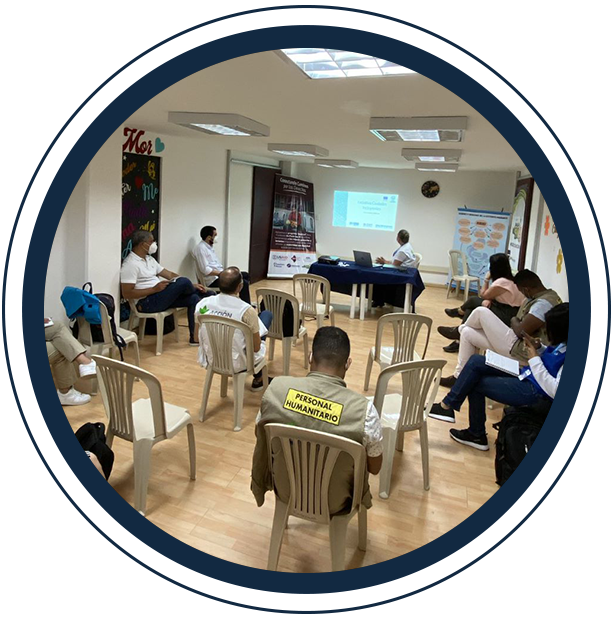The cities and communities involved in the project will have a space to share and learn about experiences and best practices both regionally and globally, and will have a systematization that will allow them to appropriate the experience and replicate it in other territories.

The local government, the community, and local strategic allies have experiences of good practices for the integration of refugees and migrants in the city.
The project facilitates spaces for the socialization of experiences around the integration of refugees and migrants in cities.
– Inclusive Cities Meeting: Actions by local governments for the integration of Venezuelan refugees and migrants and post-Covid-19 socioeconomic and territorial reactivation, held on June 7.
– The challenges of the integration of refugees and migrants with a vocation of permanence in the cities of Latin America and the Caribbean: a social, economic and urban perspective. If you want to know more click here
– The impact of migration in Latin American cities, on the way to the X World Urban Forum within the framework of the XII Global Forum on Migration and Development in Quito, on January 21, 2020. If you want to know more click here
– Participation of Barranquilla in the international Webinar “Human mobility in urban-rural areas in times of Covid-19” If you want to know more click here
The virtual space “Urban Challenges for Cohesion and Integration in the Colombian Caribbean” sought to generate a regional dialogue based on urban intervention practices, publicly position the Urban Agenda, as well as the need to identify new allies in the Colombian Caribbean.
The event included the participation of national and international experts, such as Cielo Blanco, Director of the School of Government and Leadership of the Mayor’s Office of Cartagena; Roi Chiti, Andean Countries Coordinator, UN Habitat; Ricardo Vives, Manager of the Puerta de Oro Corporation – Barranquilla Mayor’s Office; Guillermo Ávila, Secretary of Planning of Cartagena and Dagoberto Ospino, EDUS director of the Mayor’s Office of Santa Marta. The event was moderated by Alfredo Manrique, senior advisor for UN Habitat.
Among the most relevant interventions, we can highlight what was mentioned by Roi Chiti, who reiterated that large-scale projects that intervene in the public space are milestones of the integration of all sectors of the population- while simultaneously becoming icons that generate roots and identity and civic culture. Likewise, Ricardo Vives explained how through projects, such as the great Malecón del Río, actions on a metropolitan scale are recognized that allow the entire population to participate and which integrate the population with the public space. On the other hand, Guillermo Ávila mentioned that the Malecón de la Virgen is an opportunity for the edges of the city to build comprehensive projects that reduce socio-spatial segregation. Finally, Dagoberto Ospina presented the simultaneous work that they carry out with the El Rodadero boardwalk and the Bay median, which seeks to combine labor reversion strategies to avoid informality and inhabit them from a cultural, social and economic point of view.
The forum had 73 virtual and social media viewers, as reported by the School of Government and Leadership.
El evento contó con la participación de expertos nacionales e internacionales, como Cielo Blanco, Directora Escuela de Gobierno y Liderazgo de Alcaldía de Cartagena; Roi Chiti, Coordinador de los Países Andinos, ONU Habitat; Ricardo Vives, Gerente Corporación Puerta de Oro – Alcaldía de Barranquilla; Guillermo Ávila, Secretario de Planeación de Cartagena y Dagoberto Ospino, director EDUS de la Alcaldía de Santa Marta.
Entre las intervenciones más relevantes, se destaca lo mencionado por Roi Chiti, quién reiteró que los proyectos de gran envergadura, que intervienen el espacio público son promotores de la integración de todos los sectores de la población, a su vez que se convierten en íconos que generan arraigo, identidad y cultura ciudadana. Así mismo, Ricardo Vives explicó cómo a través de proyectos, como el gran Malecón del Río, se reconocen actuaciones de escala metropolitana que permiten que toda la población pueda participar e integrar a la población con el espacio público. Finalmente, Dagoberto Ospina presentó el trabajo simultáneo que adelantan con el malecón de El Rodadero y el Camellón de la Bahía, el cual, busca combinar estrategias de reactivación laboral, que mitiguen informalidad y fomente la integración desde un punto de vista cultural, social y económico.
El foro contó con 73 espectadores virtuales y en redes sociales, según lo reportado la Escuela de Gobierno y Liderazgo.